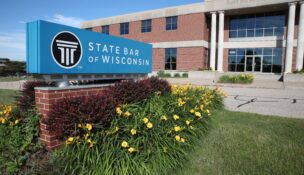EPA ‘win’ at high court could foretell future losses
By: WISCONSIN LAW JOURNAL STAFF//July 3, 2014//
EPA ‘win’ at high court could foretell future losses
By: WISCONSIN LAW JOURNAL STAFF//July 3, 2014//
By Brian Potts
and Louis Thorson
Don’t be fooled by the hype around the U.S. Supreme Court’s recent greenhouse gas decision.
The justices’ June 23 ruling in Utility Air Regulatory Group v. Environmental Protection Agency mostly upheld the EPA’s ability to regulate greenhouse gas emissions from new and modified large industrial facilities. Although the majority opinion – written by Justice Antonin Scalia – overturned parts of the EPA rule at issue, the agency immediately claimed victory. Why?
Because the court’s decision left EPA’s rule in place for the sources that emit roughly 83 percent of all greenhouse gas emissions in this country.
But the UARG decision won’t have much effect on this country’s greenhouse gas emissions or curb climate change in any meaningful fashion. That’s because the rule at issue in the case – EPA’s so-called “Tailoring Rule” – only applies to brand new facilities and existing facilities that are significantly modified or rebuilt.
Under the Tailoring Rule, such large sources have to obtain a permit and install the best available control technology for reducing emissions. To date, these BACT requirements only have led to modest emission reductions of up to about 5 percent, and only for a handful of facilities.
The Tailoring Rule at issue in UARG was EPA’s effort to trim down the number of facilities subject to greenhouse gas air permitting requirements under the Clean Air Act, which requires all new and modified air pollutant sources to obtain an air permit if they emit more than 100/250 tons of a pollutant per year.
The problem is, there are millions of sources in this country that emit more than 250 tons of greenhouse gases, and permitting all of these sources would be impractical and hugely expensive. Enter the EPA’s Tailoring Rule, whereby EPA decided that it would “tailor” these statutory major source thresholds to be more appropriate for greenhouse gases. More specifically, EPA set the greenhouse gas thresholds at 75,000/100,000 tons.
The court rejected EPA’s attempt to change the statutory 100/250-ton thresholds, but left the rule in place for what it called “anyway sources,” which are sources already subject to air permitting requirements due to their emissions of other pollutants in amounts higher than the 100/250-ton thresholds.
A win for EPA, but a loss for the climate?
Just a few weeks before the court released its UARG decision, the EPA proposed its most ambitious climate rule yet, known as its “Clean Power Plan,” which dwarfs the Tailoring Rule in significance.
The EPA’s Clean Power Plan would drastically reduce emissions from the U.S.’s leading source of greenhouse gases: existing power plants. It essentially would require American electric utilities to implement ambitious energy-efficiency programs and generate their electricity by burning less coal and using more renewable resources, such as wind and solar. The EPA plans to finalize the rule next June.
The problem is, the EPA is relying on an obscure part of the Clean Air Act, section 111(d), as its authority for the plan, and many have argued that section doesn’t give the agency the authority it wants. That’s why the following language in the court’s UARG decision could end up being so significant:
“When an agency claims to discover in a long-extant statute an unheralded power to regulate ‘a significant portion of the American economy,’ . . . we typically greet its announcement with a measure of skepticism. We expect Congress to speak clearly if it wishes to assign to an agency decisions of vast economic and political significance.”
EPA’s Clean Power Plan proposal would clearly be of vast economic and political significance. Several legislators already have attempted to repeal it, and by EPA’s own estimates the plan would cost about $9 billion per year to implement. The plan also is based on a long-extant statute: the 40-year-old Clean Air Act.
So, even though the UARG decision was technically a win for the EPA, it might come back to bite the agency if, or more likely when, EPA’s Clean Power Plan makes it to the courts.
Brian Potts is a partner and business lawyer in the Madison office of Foley & Lardner LLP. Louis Thorson is an associate in the Milwaukee office of Foley & Lardner, and a member of the firm’s environmental regulation practice.
Legal News
- State Bar leaders remain deeply divided over special purpose trust
- Former Wisconsin college chancellor fired over porn career is fighting to keep his faculty post
- Pecker says he pledged to be Trump campaign’s ‘eyes and ears’ during 2016 race
- A conservative quest to limit diversity programs gains momentum in states
- Wisconsin prison inmate pleads not guilty to killing cellmate
- Waukesha man sentenced to 30 years for Sex Trafficking
- 12-year-old shot in Milwaukee Wednesday with ‘serious injuries’
- Milwaukee man convicted of laundering proceeds of business email compromise fraud schemes
- Giuliani, Meadows among 18 indicted in Arizona fake electors case
- Some State Bar diversity participants walk away from program
- Wisconsin court issues arrest warrant ‘in error’ for Minocqua Brewing owner
- Iranian nationals charged cyber campaign targeting U.S. Companies
WLJ People
- Power 30 Personal Injury Attorneys – Russell Nicolet
- Power 30 Personal Injury Attorneys – Benjamin Nicolet
- Power 30 Personal Injury Attorneys – Dustin T. Woehl
- Power 30 Personal Injury Attorneys – Katherine Metzger
- Power 30 Personal Injury Attorneys – Joseph Ryan
- Power 30 Personal Injury Attorneys – James M. Ryan
- Power 30 Personal Injury Attorneys – Dana Wachs
- Power 30 Personal Injury Attorneys – Mark L. Thomsen
- Power 30 Personal Injury Attorneys – Matthew Lein
- Power 30 Personal Injury Attorneys – Jeffrey A. Pitman
- Power 30 Personal Injury Attorneys – William Pemberton
- Power 30 Personal Injury Attorneys – Howard S. Sicula











